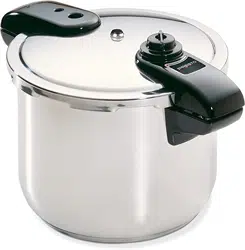Loading ...
Loading ...

3
GETTING ACQUAINTED
Your pressure cooker is like a saucepan with a very special cover that locks in place. Air is automatically exhausted and steam is sealed
inside creating pressure within the unit. Under pressure, internal temperatures in the cooker are raised above the normal boiling point
of water, causing foods to cook faster. At 15 pounds of pressure, a temperature of 250°F (121°C) is reached inside the pressure cooker.
These higher temperatures speed cooking and the moist steam atmosphere tenderizes meats naturally.
It is important to become familiar with the various parts of the pressure cooker (Fig. A, page 2) and to read the “How To Use” section
below before using the unit for the first time.
Before the first use, remove the sealing ring (Fig. B, page 2) by simply pulling it out of the inside rim of the cover. Wash sealing ring,
cover, body, trivet, and steamer basket (Fig. A) in hot, sudsy water to remove any packaging material and white manufacturing lubricant.
Rinse all parts with warm water and dry. Replace the sealing ring, being careful to fit it under the stop tabs and the lock pin (Fig. B)
which are located on the inside rim of the cover.
HOW TO USE
To assure the very best results every time, carefully follow these step-by-step instructions for pressure cooking. You may find it helpful
to refer back to Fig. A on page 2.
1. Prepare ingredients according to the directions in the pressure cooking recipe you have selected. If a larger quantity is desired, you
may double ingredients. Be sure not to overfill the pressure cooker
(see page 4 for guidance on filling).
Pour liquid into the cooker body, as specified in the recipe or time-
table. This liquid is usually water. However, some recipes will call
for other liquids, such as broth, juice, or wine.
2. Place the trivet and steamer basket into the cooker, if called for in
the recipe (see “Helpful Hints” on page 7 for guidance on when to
use). If using the trivet, position it in the cooker so the loop ends
are towards the bottom of the cooker (Fig. C).
3. IMPORTANT: Look through the vent pipe to make certain that it is clear before placing the cover
on the cooker body (Fig. D). See safety information on page 5. If blocked, clean as described on
page 6, step 4.
Placethecoveroverthebody(Fig.E),aligningthe▼markonthecoverwiththearrowoneither
of the body handles. Move the cover handle slightly until the cover drops into position.
4. Close the cover securely by rotating it clockwise until the cover handles are directly above the
body handles. The pressure cooker is completely closed when the cover handles are directly
above the body handles (Fig. F). Do not try to rotate it beyond this point.
5. Place the pressure regulator on the vent pipe and rotate clockwise until the lever on the regulator
is aligned with the pressure arrow (Fig. G). NOTE: It may be necessary to apply slight pressure
when positioning the regulator on the vent pipe to seat it properly.
6. Position the pressure cooker on your stove. If your stove is electric coil or smooth top, use the
largest element, making sure the element does not extend more than one inch out from the cooker
bottom.
Using a high heat setting on your stove, begin heating the pressure cooker. As pressure is building,
a small amount of steam will be released from the pressure regulator. You will know your cooker
has reached 15 pounds pressure when you hear and/or see a steady flow of steam releasing from
the pressure regulator.
NOTE: The air vent/cover lock may move up and down a few times when cooking first begins as
it automatically exhausts air from the pressure cooker. Steam will be noticeable. This is normal.
When pressure begins to build, it slides up, locking the cover on. Once the cooker has sealed,
the air vent/cover lock will remain in the up position until pressure is released (Fig. H, page 4).
7. Cooking time begins when you hear and/or see a steady flow of steam releasing from the pres-
sure regulator. Lower the heat as necessary to maintain a very slow, steady flow of steam and
cook for the length of time indicated in the recipe or cooking chart. If excess steam is allowed to
escape, too much liquid will evaporate and food may scorch. Never leave your pressure cooker
unattended at high heat settings. It could boil dry, overheat, and cause damage to the pressure
cooker.
Vent Pipe
Fig. D
Loop Ends
Fig. C
Position the trivet in the cooker so the
loop ends are towards the bottom of
the cooker.
Air Vent/
Cover Lock
Vent Pipe
Fig. E
▼Mark
Fig. F
Pressure
Regulator
Fig. G
Lever
Pressure
Arrow
Loading ...
Loading ...
Loading ...
